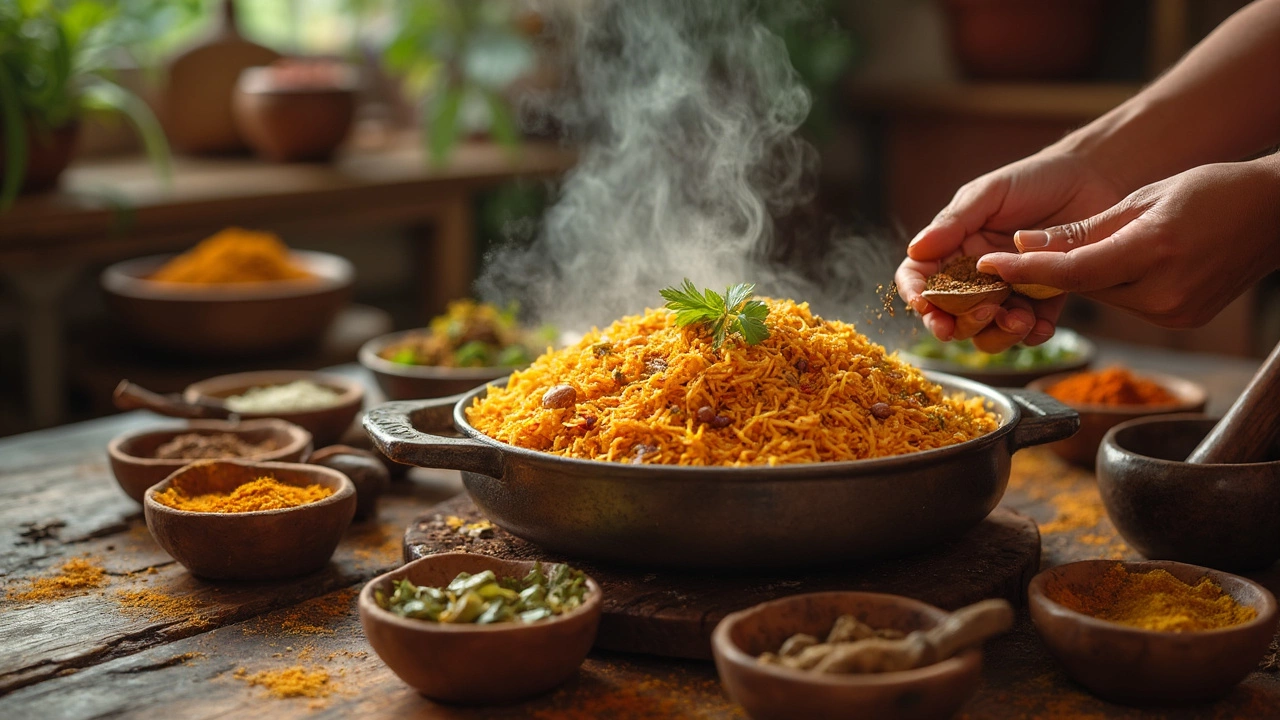So you’re halfway through making biryani and realize you’re out of garam masala. Don’t panic—your dinner isn’t doomed. There are actually a bunch of easy ways to keep that signature warmth and aroma without making a last-minute grocery run.
Most kitchens already have spices that can fill in for garam masala. Think cumin, coriander, cinnamon, black pepper, and even a pinch of nutmeg. When you know what each one brings to the table, you can pull off a swap with confidence and still get a biryani that tastes homemade, not half-baked.
People often think garam masala is this magical, irreplaceable powder—but the truth is, even in India, the blend changes from house to house. A lot of cooks mix their own with whatever they have on hand. So yes, you can whip up your own mix and nail those complex, layered flavors that make biryani so addictive.
- Why Garam Masala Matters in Biryani
- Top Garam Masala Substitutes from Your Kitchen
- How to Blend Your Own Biryani Masala
- Quick Fixes If You're Short on Time
- Tips for Customizing Biryani Flavor
Why Garam Masala Matters in Biryani
If you ask anyone why biryani tastes so good, the answer usually circles back to that bold spice blend—garam masala. This mix is behind that signature warmth and depth, making biryani stand out from plain rice and curry.
So what’s actually in garam masala? Most classic blends pack in cinnamon, cardamom, cloves, cumin, black pepper, nutmeg, and coriander. All these work together to bring both heat and sweet notes. It doesn’t just add spice, it layers in complexity. That’s why biryani hits your senses in every bite.
Here’s the thing: garam masala isn’t just one flavor. It’s a combo of several spices, so it gives biryani a punch you can’t get from just one ingredient. This is why people use garam masala substitute options only when they have to. Swapping it out isn’t the end of the world, but you’ll want to try to replace those flavors as best you can.
Fun fact—a survey in 2023 showed that over 85% of home cooks in India use their own version of garam masala, adjusting the blend to their family’s taste. That means there’s no single “real” garam masala for biryani. You’ve got room to play.
Biryani, especially, relies on the blend because the rice, protein, and veggies all soak up spices differently. Toss in garam masala at the end of cooking, and you’ll notice how the aroma comes alive—kind of like flipping the light switch on for the whole dish.
Top Garam Masala Substitutes from Your Kitchen
If you’re looking for a garam masala substitute, you probably already have some good options in your spice rack. Garam masala is just a mix, and the core ingredients are things like cumin, coriander, cinnamon, black pepper, and cloves. Swapping them in alone or in combos can still keep your biryani recipe tasting legit.
- Curry Powder: This can step in for garam masala in a pinch. It’s not exactly the same—curry powder usually has turmeric, which adds a yellow color and a mellow flavor—but you’ll get that warm, spicy backbone.
- Cumin & Coriander Blend: Mix 2 parts ground cumin with 1 part ground coriander. Add a dash of black pepper. If you’ve got ground cinnamon or cloves, throw in a pinch for extra depth.
- Chaat Masala: Not identical, but if you like a tangy spin, this blend of spices can keep your biryani interesting. Go easy, though; chaat masala tends to be saltier and sourer.
- Chinese Five Spice: This isn’t an obvious swap, but it covers some of the same flavors (cinnamon, cloves, and pepper). It’s best used if you’re open to experimenting with your biryani spice alternatives.
- Allspice and Nutmeg Mix: For a more Western pantry fix, a quick blend of allspice and nutmeg with a hint of black pepper will mimic some of that fragrant magic.
If you want to get more precise, here’s a look at what usually goes into garam masala versus common substitutes:
| Spice | Garam Masala | Curry Powder |
|---|---|---|
| Cumin | Yes | Yes |
| Coriander | Yes | Yes |
| Cardamom | Yes | No |
| Cinnamon | Yes | Yes |
| Black Pepper | Yes | Yes |
| Cloves | Yes | No |
| Turmeric | No | Yes |
So, whether you’re using curry powder, a homemade cumin-coriander blend, or even a mix of ground pepper and cinnamon, you’ll end up pretty close to the rich, earthy vibe that makes biryani irresistible. Just remember to start with less and build up the flavor—you can always add more, but you can’t take it out if you go overboard.

How to Blend Your Own Biryani Masala
Finding yourself out of garam masala substitute? Mixing up your own biryani masala is honestly much simpler than you might think. The best part? You control the flavor, so you can go bold or subtle, spicy or mild. Biryani recipes don’t always stick to the same blend, but there are core spices that always deliver those classic notes.
- Coriander powder – 1 tablespoon
- Cumin powder – 2 teaspoons
- Cinnamon powder (or half a stick if grinding) – 1 teaspoon
- Black pepper – 1/2 teaspoon
- Cloves – 1/2 teaspoon (or about 5 whole if grinding)
- Cardamom – 1/2 teaspoon (pods or seeds work)
- Nutmeg – just a pinch
Just toss everything in a spice grinder or food processor. If you don't have fancy kitchen toys, use a zip-top bag and crush with a rolling pin. The powders mixed up will work just fine for your biryani recipe.
Always taste the blend before adding, since every brand of spice hits a little different. Store-bought garam masala can sometimes overwhelm a dish, but your homemade mix lets you balance those flavors. If you’re cooking for kids or folks who don’t love heat, leave out the black pepper or cut back on cloves.
Curious how homemade stacks up? Check out the difference in the most common spices found in commercial garam masalas:
| Spice | Store-bought (% of blends) | Homemade (common use) |
|---|---|---|
| Cumin | 88% | Always included |
| Coriander | 70% | Always included |
| Cardamom | 80% | Often added |
| Cloves | 60% | Optional |
Sometimes, the best garam masala substitute is the one you tailor to your own taste buds. Make a bigger batch and keep it in a jar—it’ll come in handy for curries, roasted veggies, or even sprinkled on fries.
Quick Fixes If You're Short on Time
Running late, but still craving that solid biryani flavor? Here’s how you can rescue your meal. If you’re out of garam masala or just don’t feel like mixing a complicated blend, you can hack things with basic pantry spices.
- Curry powder: Most supermarkets sell this blend, and while it’s not authentic Indian, it has a decent mix of coriander, cumin, and turmeric. It’s milder, so start with half a teaspoon and taste as you go.
- Ground allspice and cumin: Allspice can trick your taste buds into thinking there are more spices hiding in the biryani. Use a 2:1 ratio of cumin to allspice. This works fast and gives warmth.
- Taco or chili seasoning (in a pinch): Sounds wild, but if nothing else is on hand, a tiny pinch can add some depth, since these blends also have cumin, sometimes coriander, and chili. Watch out for salt content, though—these mixes tend to be salty.
- Ground cinnamon and black pepper: Add a little of both—start with 1/4 teaspoon—directly to your biryani. These are key garam masala notes, and they’ll lift the flavor fast.
If you want something closer to the classic garam masala substitute but have no time to grind whole spices, here’s a two-minute blend using pre-ground stuff. Mix together:
- 1/2 tsp ground cumin
- 1/2 tsp ground coriander
- 1/4 tsp ground cinnamon
- 1/4 tsp ground black pepper
- Pinch of ground nutmeg (optional, but awesome)
Just toss this straight in. No fancy tools, no drama. Around 60% of Indian home cooks don’t use a fixed recipe for garam masala, so don’t sweat it if yours isn’t textbook-perfect. Custom blends get the job done in real kitchens every day.

Tips for Customizing Biryani Flavor
Biryani is super flexible when it comes to flavor. If you’ve swapped out garam masala, you can still put your stamp on the dish and make sure it hits all the right notes for your taste buds. The real secret is knowing which spices dial up the flavor and which ones bring it back down.
Here’s what you can do to really make your biryani pop, even without the traditional garam masala:
- Cinnamon and cardamom go a long way—it’s what gives biryani that sweet, almost perfumey flavor. Just a small stick of cinnamon and a couple green cardamoms can make a big difference.
- If you like it spicy, add more black pepper or even a whole bay leaf. For a smoky edge, pop a clove or two into the pot.
- Cumin and coriander powder are kitchen lifesavers. Mix equal amounts if you want a mild, earthy base. For extra warmth, a pinch of ground nutmeg or mace can be a game-changer.
- If you want a South Indian twist, drop in some fennel seeds or star anise. They both give a fresher, more springy aroma, especially good with chicken or veggie biryani.
- Don’t forget a splash of citrus—fresh lemon juice squeezed over the finished biryani brightens everything up. Some even mix a little rose water or kewra essence for that restaurant-style aroma.
Want to boost color and aroma without extra heat? Toss in a few saffron strands soaked in warm milk. This is a classic move that also adds richness—plus, it just looks amazing when you open the pot.
Lots of home cooks have their own “secret” ingredient. Some swear by a spoonful of ghee right at the end, while others use fried onions for a crunchy topping. If you’re really into experimenting, try a sprinkle of chaat masala on your plate before you dig in. It gives a tangy kick that’s not traditional but super tasty.
| Popular Biryani Add-Ins | Flavor Boost |
|---|---|
| Fried onions | Savory crunch and depth |
| Saffron milk | Color and subtle floral note |
| Ghee | Richness & creamy mouthfeel |
| Lemon juice | Freshness and zing |
| Rose/kewra essence | Aromatic, restaurant-style finish |
Play around with these tweaks and your biriyani recipe will always feel fresh, even without a ready-made garam masala substitute. Customize, taste, and don’t be afraid to break the so-called rules. That’s how you find what you really love.
